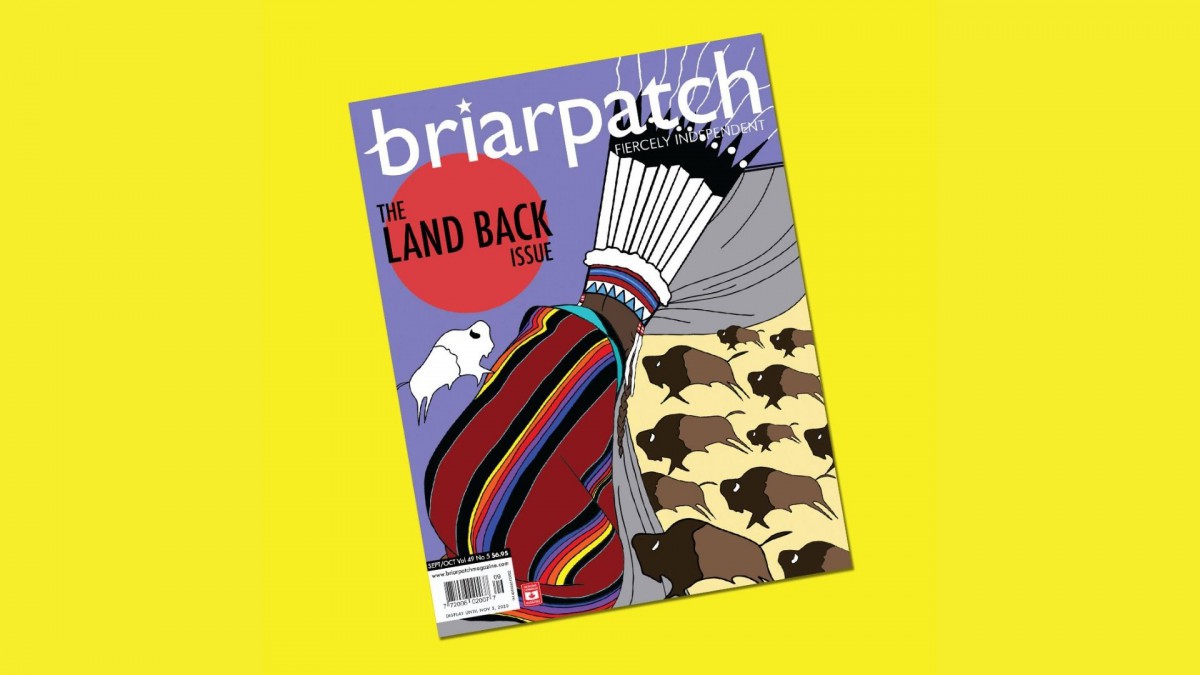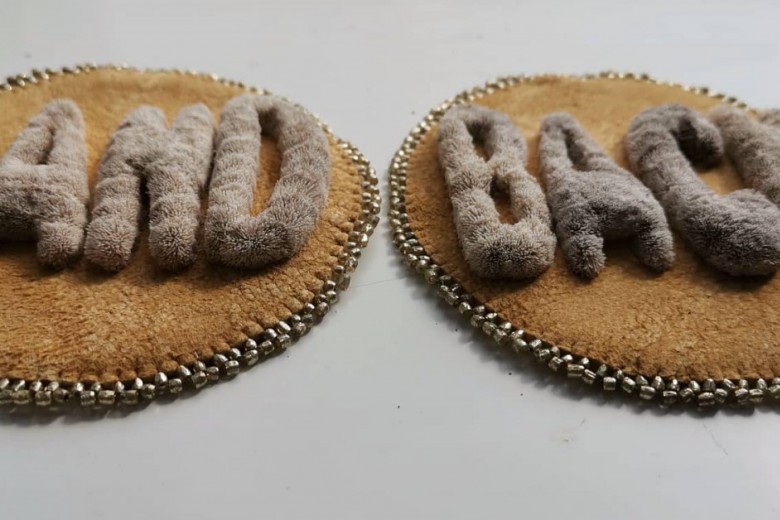In Swampy Cree the word for land – “aski” – is inanimate. As Alex’s father Stan explained to her, land, alone, cannot perpetuate itself; it takes rain, air, sun, and more. Thus, it is the land’s spiritual connections that animate it. There is a spirit not in the soil, but in the whole system.
“Land Back” is the demand to rightfully return colonized land – like that in so-called Canada – to Indigenous Peoples. But when we say “Land Back” we aren’t asking for just the ground, or for a piece of paper that allows us to tear up and pollute the earth. We want the system that is land to be alive so that it can perpetuate itself, and perpetuate us as an extension of itself. That’s what we want back: our place in keeping land alive and spiritually connected.
The length of this issue and the breadth of contributions it contains shows that Land Back is an incredibly complex call to action. As Emily notes, “Land Back requires us to consider how we may govern ourselves within the intentions and traditions of our ancestors.” Mike Gouldhawke explains that land is fundamentally a social relationship. jaye simpson writes about the importance of who the land is governed by, and of excising transmisogyny from our social movement spaces. Lindsay Nixon reminds us that the city is land, too.
That’s what we want back: our place in keeping land alive and spiritually connected.
“With land comes knowledge,” Alex notes. “Our knowledge, cosmologies (how we understand ourselves within the wider multiverse), and all of the relational structures that connect to that knowledge have been impacted and, to some degree, severed by colonialism. When we say ‘Land Back,’ we are acknowledging and invoking those ancient knowledge systems and calling for a validation of them in our contemporary times.”
So much of the writing in this issue brings this ancient knowledge to life, both in the streets and out in the bush. Dr. Lana Whiskeyjack and Kyle Napier write about learning nêhiyawêwin and visiting the Kâniyâsihk Culture Camps. Three Indigenous women hunters discuss the intimate relationship that hunting allows them to form with the land. Adrienne Huard and Jacqueline Pelland write about the necessity of ceremony that welcomes sex workers. Ginnifer Menominee talks about honouring the treaties by respecting ceremonial jurisdiction.
Land Back isn’t a new concept – just, perhaps, a new hashtag. Indigenous people have been fighting against land theft for hundreds of years, as Mike Gouldhawke’s “100 years of land struggle” shows. This past year alone has been packed with reminders of the power of Indigenous resistance to colonialism. We began 2020 with hundreds of international solidarity actions with the Wet’suwet’en Nation. We moved into a pandemic, during which Indigenous Nations practiced their sovereignty to ensure the safety and health of their communities. We received news that the Dakota Access pipeline was suspended. We paid our respects as we reached the 30th anniversary of the siege of Kanehsatà:ke and the ninth anniversary of Idle No More. And we watched in awe as the land defenders at the Pekiwewin camp and 1492 Land Back Lane reclaimed their territory. “Indigenous Nation-to-Nation solidarity is an uncompromising force,” Nickita explains. “Our joint efforts in denying further destruction of our lands by the settler state literally has the power to shut down Canada and beyond.”
“Our knowledge is linked to land and language. We have survived and thrived for tens of thousands of years and will continue to exist because of this knowledge, and despite colonial attempts."
This year also gave momentum to a powerful wave of ongoing Black liberation protests and calls to abolish the police. It is a crucial reminder that Land Back cannot happen while the settler state continues to kill Black and Indigenous people – through police violence, through incarceration, and through child apprehension. Emily reminds us that all Indigenous Nations on this continent have Black citizens, and many Black people who are not Indigenous to this land were violently removed from theirs. “Land Back must include the liberation of Black people,” she says.
In the end, Indigenous knowledge and land co-constitute each other, which is why we hope that a magazine issue packed with Indigenous writing and art will help amplify, sharpen, and expand the Land Back movement. “Our knowledge is linked to land and language,” Alex reminds us. “We have survived and thrived for tens of thousands of years and will continue to exist because of this knowledge, and despite colonial attempts. We are not defined by colonialism and can exist in healthy and powerful ways in connection to the lands and relations that we ascended from.”
“All of Canada is Indigenous land whether it is Treaty Land or not,” Emily adds. “Settler legal systems make the logistics of getting our land back difficult, but they also challenge us to bust open those systems and radically change the way we relate to each other on this continent.”
The Land Back Editorial Collective:
Nickita Longman
Emily Riddle
Alex Wilson
Saima Desai
A note on our style guide
Making the Land Back issue meant, in many ways, rebuilding Briarpatch from the ground up. So much of Briarpatch’s production process was created without Indigenous writers, artists, knowledge, and Protocols in mind. Here are some of the changes to our style guide that you might notice in this issue.
We chose not to standardize the spelling of Indigenous words or names in this issue. We want to preserve regional dialects, and we understand that many Indigenous words are artificially standardized by colonial researchers. For example, “Anishnaabe,” “Anishinabe,” “Nishnawbe,” and “Neshnabé” are all terms that refer to the same group of people, but have different spellings in different dialects. Writers were free to use whatever spelling they thought was most accurate, or whatever spelling they arrived at in consultation with members of the community.
We chose not to italicize words in Indigenous languages, or any other non-English languages. When Cree words are written in Standard Roman Orthography, we do not use capital letters.
Taking guidance from Gregory Younging’s Elements of Indigenous Style, we chose to capitalize words referring to Indigenous identities, institutions, and collective rights, including Elder, Knowledge Keeper, Hereditary Chief, Two-Spirit, Treaty Right, Treaty Land, Traditional Territory, Indigenous Nation, Indigenous Peoples, Clan, Sweat Lodge, and Protocol.
A note on our funding
To make this issue, Briarpatch accepted $3,000 of funding from Journalists for Human Rights’ Indigenous Reporters Program. JHR is a non-partisan Canadian media development organization. All of that money went toward paying Indigenous contributors and editors, and it meant we could pay some of them hundreds of dollars more than Briarpatch can usually afford. Some of JHR’s money for the program comes from RBC. RBC is not engaged in the individual partnerships made between JHR’s Indigenous Reporters Program and publications, meaning that RBC did not have any influence over the editorial content of this issue.
RBC is the bank that advised TC Energy, the company forcing the Coastal GasLink pipeline through unceded Wet’suwet’en territory. We want RBC to know that Land Back means an end to capitalism and resource extraction that displaces people and poisons land and waters. But in the end, we thought we could do more good by accepting the funding, being transparent with you about its source, and using it to give radical Indigenous writers who are committed to dismantling petro-capitalism a bigger platform.
About the cover art
Title: “Land Back West to East”
Medium: Multimedia/Digital
By Hali Heavy Shield
“Land Back West to East” references the importance of women in the Land Back movement and reflects on what it means for Indigenous communities to have basic human rights to food security, housing, ceremonial practices, and peaceful living.
Nato’yi’kina’soyi (Holy Light that Shines Bright) / Hali Heavy Shield is a multidisciplinary artist and educator and is a member of the Blood Tribe (Kainai) of southern Alberta. Hali’s work is influenced by experiences in her home community, including Blackfoot stories, significant sites, family, and women as sources of strength and goodness. She often uses vibrant colours, text, and symbolism to braid contemporary and traditional Indigenous realities with imagined futurisms. Hali is also a literacy and 2SLGBTQ activist who works to engage others in generative discussion and practices of reconciliation and creativity. She is currently a PhD student at the University of Lethbridge researching Blackfoot narratives and visual art.








